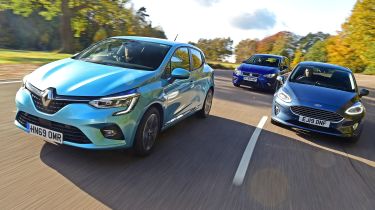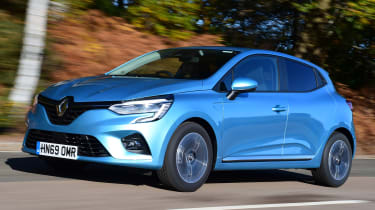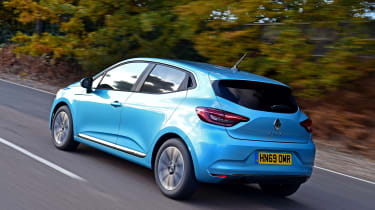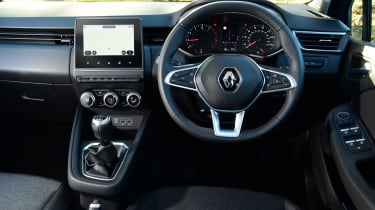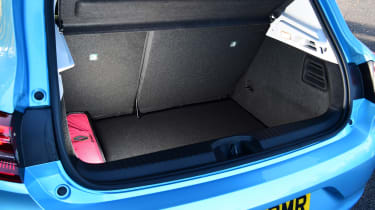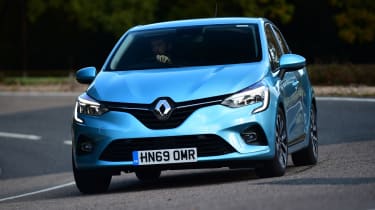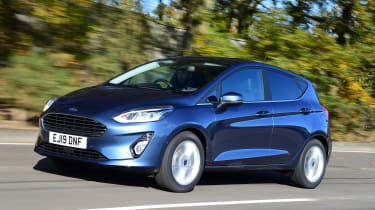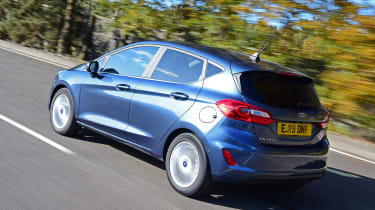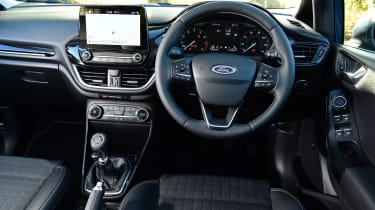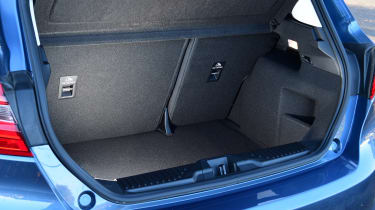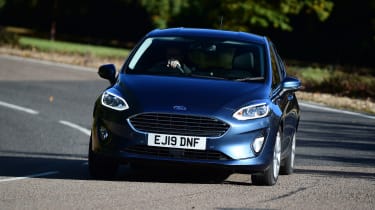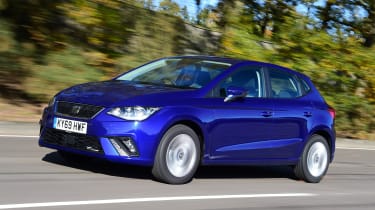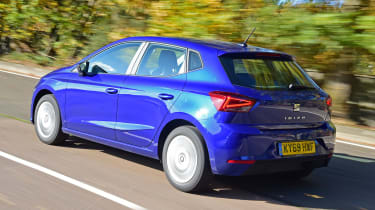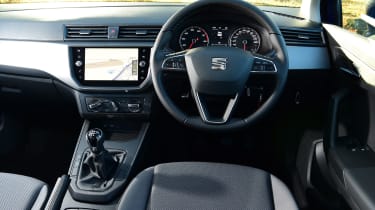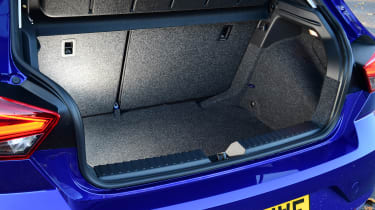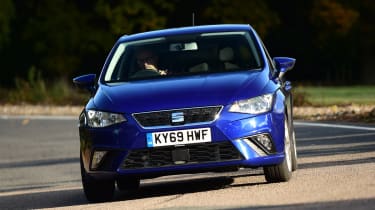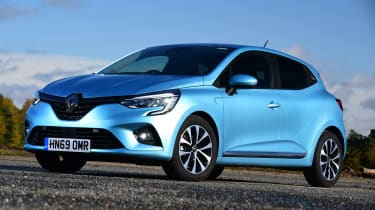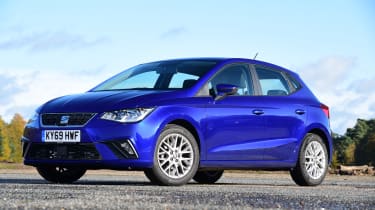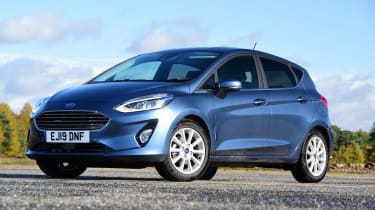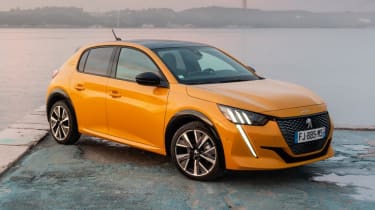Renault Clio vs Ford Fiesta vs SEAT Ibiza
Has the new Renault Clio got what it takes to beat the Ford Fiesta and SEAT Ibiza?
French car manufacturers have traditionally been strong when it comes to their small, affordable cars, yet it’s fair to say recently other brands have had it more their own way in the supermini sector. But now Renault has returned with its new, fifth-generation Clio.
Over the past four iterations it’s mobilised generations of new drivers, taken countless commuters to and from work and covered almost every base in between.
• Best hatchbacks on sale right now
But the fourth version wasn’t exactly the best model in its class and the humble supermini has evolved to the point where it now has an operating window that’s broader than ever. Take the Ford Fiesta and the SEAT Ibiza, for example. These cars arrived in the summer of 2017 and set the class alight, heading straight to the top.
Both hatchbacks are fun to drive, frugal, offer good tech, enough practicality to even occasionally operate as family transport, and should be cheap to run, so these two models represent the yardstick by which the new fifth-generation Clio will be judged.
That means there is nowhere to hide for the new Renault, but with a smarter cabin and fresh engines, the signs are positive. Let’s see how it fares.
Renault Clio
| Model: | Renault Clio Tce 100 Iconic |
| Price: | £16,295 |
| Engine: | 1.0-litre 3cyl turbo petrol, 99bhp |
| 0-60mph: | 11.2 seconds |
| Test economy: | 44.0mpg/9.7mpl |
| CO2: | 99g/km |
| Annual road tax: | £145 |
In Iconic trim with Renault’s TCe 100 engine, this new Clio comes in at an affordable £16,295, undercutting its rivals. But is it short on ability?
Used - available now
Design & engineering
There’s a lot that’s fresh with this fifth-generation Clio. The CMF-B platform is all-new for Renault’s supermini (the last three versions were based on the older Renault-Nissan Alliance B platform), which uses MacPherson-strut front suspension and a torsion beam at the rear. It’s a standard layout for a car of this type at this price point.
The platform has improved packaging, as we’ll see, but it also houses the new TCe 100 engine. This is a 99bhp 1.0-litre three-cylinder turbo unit, which puts it on par with its rivals in this test and most of the supermini class. But while it’s equal on power, the Clio is slightly down on torque, offering 160Nm. At 1,178kg, it’s also the heaviest car here, so we’ll see if this affects its performance and efficiency.
On paper, though, the Renault certainly looks strong. Performance only has to be adequate, so equipment might be more important and here the Clio succeeds, offering more standard features than its rivals, despite costing less than them.
Iconic trim comes with sat-nav, the latest phone connectivity, LED lights, cruise control, some strong safety kit and parking sensors. Neither the Fiesta nor the Ibiza matches this level of standard equipment, as we’ll see. You can also add some optional kit that’s not available on the trim levels were testing its rivals in, such as climate control (£300).
Despite the Mk5 Clio representing an obvious refinement of what went before it, the Renault has really taken a boost in quality. With its Mégane-style running lights and a sharper rear end, the Clio looks more mature, and it feels it inside, too. Material quality is good and despite the new hatchback being a little shorter than its predecessor, the dashboard and other trim have been redesigned to make more space. Ergonomics are also better than before.
Driving
The Clio’s strongest suit is its blend of ride and refinement. On 16-inch alloys in Iconic trim it smooths out bumps quite well. It feels less bobbly than the Ibiza, which admittedly has more body control and is a lot less focused than the Fiesta, but then the Ford reacts more harshly to bumps the Clio is less upset by.
The Clio’s air of calm is helped by the quiet engine and good insulation from road and wind noise. There isn’t much clonking from the suspension, so the Clio is a solid cruiser and relaxing to drive. That’s good, because it certainly doesn’t handle or perform anywhere near as well as either of its rivals here.
While the TCe 100 unit whispers away, it feels sluggish and our performance figures showed as much, with the Clio one second slower than the Ibiza from 0-60mph and 1.2 behind the Ford.
With less torque, its in-gear acceleration was much weaker, too. In fifth the Renault took 15.7 seconds between 50 and 70mph. The other five-speed car, the Ibiza, took just 12.2, which was two seconds slower than the Ford. However, the Fiesta has an extra ratio to play with, so it was no surprise it was quicker. The Renault’s five-speed manual’s shift action is also the worst. It feels baggy and indistinct compared with the SEAT’s sweeter action and isn’t as nice as the Ford’s lighter, more positive shift. But the Clio’s performance downsides can’t take away from the positives. It’s just about fast enough, and the ride and refinement are good.
Practicality
Those improvements in packaging thanks to the new chassis architecture and a redesigned cabin are noticeable. The Clio is roomy enough inside and roughly on par with the Fiesta in the back but tighter than the Ibiza, which is one of the bigger models in the class.
The boot is larger than both its competitors in this test, too, at 391 litres. That’s even bigger than the outgoing Volkswagen Golf from the class above, which shows how versatile this Clio is.
Renault has pulled off the clever trick of shrinking the Clio’s footprint for this fifth-generation model, making it easier in town, yet improving the space on offer inside and in the boot. Storage is also good, with enough trays and bins to take all the possessions you’ll carry with you on a daily basis.
Ownership
It’s fair to say Renault didn’t perform brilliantly in our Driver Power 2019 ownership survey, finishing 19th in the manufacturers’ chart. That was five placesbehind SEAT but four ahead of Ford.
The Clio’s five-star Euro NCAP safety score matches its rivals’, but they were tested back in 2017, so the Clio’s result carries even more weight. Iconic trim features autonomous emergency braking as standard, along with lane-keep assist and six airbags. Extra safety tech, such as blind-spot warning, is only available on the top trim level, as per the Ibiza.
Running costs
Renault's hatch is the cheapest and emits the least CO2, at 99g/km, so is in the 23 per cent Benefit-in-Kind tax band. That makes it the most cost-effective company car, at £741 a year for lower-rate earners. The Ibiza is next when it comes to CO2, BiK and company car tax, at 104g/km, 24 per cent and £793 a year for the same taxpayer.
The Ford is quite a bit pricier. That’s partly because it costs so much more (turn over to see why) and also emits more CO2, at 108g/km, which puts it in the 25 per cent BiK bracket. It’ll cost £100 more per annum than the Ibiza for a business user.
Testers’ notes
“The Clio is the best-selling French car of all time, with more than 15 million models finding homes. By the signs of this fifth-generation model, the Renault’s future seems as bright as its past.”
Ford Fiesta
| Model: | Ford Fiesta 1.0 EcoBoost 100 ST-Line |
| Price: | £18,070 |
| Engine: | 1.0-litre 3cyl turbo petrol, 99bhp |
| 0-60mph: | 9.8 seconds |
| Test economy: | 43.8mpg/9.6mpl |
| CO2: | 108g/km |
| Annual road tax: | £145 |
It's our current class leader, but is the Ford Fiesta about to slip down the rankings? We’re testing the 1.0 EcoBoost 100 model in five-door ST-Line trim (Titanium X pictured) to find out.
Design & engineering
In this specification the Fiesta costs £18,070 – £1,775 more than the Clio, which is quite a significant chunk of cash at this price point. While you should be able to walk into a Ford dealer and haggle a little, this is partly because the brand doesn’t list the Zetec trim level in its price lists any more. That spec was closest on price to the Clio, but now it’s the ST-Line model we’re testing here, which means you’ll have to shell out a bit more cash for no more equipment.
For example, the Fiesta doesn’t get sat-nav as standard; it’s a £550 option. However, an eight-inch touchscreen is included with good connectivity. You don’t get parking sensors, either (£300), AEB is extra (£400 as part of a pack) and cruise control – which is included on the Clio – costs £150.
However, ST-Line does feature Apple CarPlay and Android Auto, DAB radio, lane-keep assist, air-conditioning, sports seats, a heated windscreen and racier styling to go with its 17-inch alloys.
Quality in the Ford is okay. Its interior is robust rather than plush, but none of these cars offers stunning quality – even the improved Clio, which makes the Fiesta look pricey in this company.
While the trim line-up might have changed, the engineering underneath hasn’t, which means the Fiesta’s engine and chassis are familiar and still more than competitive. The suspension layout matches the Clio’s, but the Ford is undoubtedly sportier and more responsive, as we’ll see.
The 1.0-litre three-cylinder turbocharged EcoBoost petrol is rated at exactly the same power as the Clio’s; however, it has 10Nm more torque in a lighter package, so performance should be good. It’s the only car of this trio to use a six-speed manual gearbox, too.
Driving
This Fiesta redeems itself with the way it drives, because it’s still the most fun car in its class. The engine doesn’t rev much beyond 4,500rpm, but the mid-range is punchy enough, so with the shorter gearing thanks to the six-speed box it’s worth changing up and using the motor’s torque.
Its positive performance showed at the track against the stopwatch. The Fiesta took 9.8 seconds to sprint from 0-60mph, highlighting its acceleration advantage over its rivals, which is thanks, in part, to its six-speed gearbox.
All three cars cover a similar speed range, so with an extra ratio to play with, the Fiesta has more flexibility. Our numbers show the Ford was around a couple of seconds quicker than the Clio over each in-gear test, but what this really means is you have to work the gearbox less for the same performance.
The transmission’s shift action is light and positive; it’s not as precise as the SEAT’s but is more pleasant than the Clio’s sloppier box. It doesn’t take many miles to realise that the Fiesta is set up to be sporty. It’s the most responsive car, especially so in ST-Line trim, with light but quick steering for this class that means the Ford darts towards the apex of any corners, delivering real enjoyment.
Grip is great for a supermini, while the sportier suspension set-up means body roll is well controlled. This is easily the most dynamic car of the three, but while it’s firm, the quality of the suspension damping means it’s not uncomfortable, even if it doesn’t match the smooth-riding Renault here.
Only the worst inputs crash through the Fiesta��s chassis, otherwise the car does pogo around a little, but settles down at higher speeds.
Practicality
Not so long ago the Ford’s 311-litre boot was acceptable, and while it’s still more than enough for most day-to-day duties and occasional weekend trips, it is outclassed by both rivals, particularly the 391-litre Clio.
The tables are turned with the rear seats down, though, because the Ford offers 1,093 litres compared with the Renault’s 1,069 litres.
This also shows how much more cabin space the Fiesta offers in the rear. The Clio feels more cramped than the Ford and access isn’t quite as easy. The Fiesta is a little less roomy than the Ibiza.
However, the Fiesta’s driving position is the best. The ergonomics are good and storage is fine, too.
Ownership
The Ford’s Euro NCAP rating is a match for its rivals’, but it doesn’t feature as much safety kit. Autonomous braking is a £400 extra, for example, which adds adaptive cruise and pedestrian detection, too. Both cars the Fiesta is up against boast AEB tech as standard.
Its maker’s rating wasn’t great amongst owners because it claimed 23rd spot out of 30 brands in our Driver Power 2019 poll. Its dealer network took the same position in this part of the survey, but at least you won’t have to travel far to find a Ford garage, because there are so many across the UK.
Running costs
Servcing the Fiesta costs £547 for a three-year package, which is an average of £182 per year, while the Renault’s £449 three-year package works out an average of £150 per year. It’s more cost-effective than the Ibiza, too; the Spanish manufacturer’s £384 two-year pack works out at £192 per service.
Insurance costs are similar, too. The Ford will cost our sample driver £411 to cover, while the Renault and SEAT came in at £355 and £350 respectively.
Testers’ notes
“Zetec was the sweet spot of the Fiesta line-up, balancing kit and cost, so it’s a shame Ford has removed it from sale. When we contacted Ford it was unsure if it would reappear.”
SEAT Ibiza
| Model: | SEAT Ibiza 1.0 TSI 95 SE Technology |
| Price: | £16,735 |
| Engine: | 1.0-litre 3cyl turbo petrol, 94bhp |
| 0-60mph: | 10.2 seconds |
| Test economy: | 44.0mpg/9.7mpl |
| CO2: | 104g/km |
| Annual road tax: | £145 |
Along with the Fiesta, it’s the Ibiza the Clio has to beat if it wants to take class honours – and looking at the price of this £16,735 1.0 TSI 95car in SE Technology trim, the SEAT could prove to be closer competition than the Ford.
Design & engineering
The Ibiza is based on the A0 version of the MQB platform that cemented the fortunes of parent company, the Volkswagen Group. It’s the same platform that underpins other superminis, such as the VW Polo.
That means that, as in its rivals, the suspension layout is conventional, as is the choice of engine and gearbox. It’s SEAT’s 94bhp 1.0-litre TSI unit, whichis linked to a five-speed transmission. The motor produces 175Nm of torque (the most here) and both the Fiesta and Ibiza produce their maximum punch from low down, at 1,500 revs. The Clio needs 2,750rpm for its 160Nm maximum output.
A quick look at the dimensions of this trio shows they’re all just under 4.1 metres long – proving how superminis have grown over the years – but that they’re also increasingly practical. In the Ibiza’s case a lot of that characteristic comes from the kit you get in mid-spec SE Technology trim.
Its price tag of £16,735 is only £440 more expensive than the Clio outright (see our Through the range column, right, to see how it fares on finance), yet it’s £1,335 cheaper than the Fiesta.
SE Tech has an eight-inch touchscreen with nav, Apple CarPlay and Android Auto, plus DAB radio and connected services. Yet a lot of equipment isn’t even available as options.
Material quality isn’t a match for the Clio’s and the Fiesta’s plastics feel just that little bit nicer, but then the Ford is also a more expensive car, so the Renault and SEAT certainly look better value. Besides, some hard plastics on the dash and doors aren’t too much to put up with given the level of kit on offer and the money that’s been spent elsewhere to ensure supermini buyers receive their priorities. All three cars succeed in some way or another on this front.
Driving
The Ibiza isn’t quite as sporty as the Fiesta, but it’s not far off. The steering is lighter and more dead-feeling compared with the Ford, while the body control isn’t quite as impressive. But the trade-off is a car that rides with almost as much composure as the Fiesta, even if it’s not quite as forgiving or as refined as the Clio. There’s more road noise than in the Renault.
In all three cars you get bumped around a bit at mid-speeds on bad roads, but the Ibiza feels stiffer and harsher than the Clio and more closely matched with the Ford, which is skewed more towards performance and handling than the softer French supermini. Yet the Ibiza is settled at speed and feels relatively mature on the motorway, like the Fiesta.
Part of that is due to its engine, which is punchier and more linear than the Clio’s unit. There is a slight hesitation on a light throttle before the Renault’s TCe turbo’s boost comes in.
The Ibiza is much gutsier and more predictable, which makes it easier to drive, too. Both the Ford and SEAT are better in this respect, although it’s the Ibiza’s engine that revs harder, even if with its five-speed gearbox it wasn’t quite as fast.
There’s enough performance, though. You feel the Clio could do with an extra gear due to the engine’s slight lethargy, but the Ibiza’s torquey mid-range means this isn’t as much of a problem.
The Spanish hatchback’s five-speed manual’s gearchange action is the nicest of the three, with the most positive feel to the shift.
Practicality
At 355 litres with the seats up, the SEAT splits its two rivals for boot space. But it’s the largest when it comes to room inside the rear of the cabin. This feels almost as big as a Leon from a few generations ago. That’s progress. It’s much roomier than the Clio and edges the Ford out.
Yet storage is one of the Ibiza’s slightly weaker points compared with its rivals’ offerings. The big tray in front of the gearlever is somewhere for your phone and wallet; here it’s not so important because the wireless smartphone charging plate that sits in this position on some rivals isn’t even available as an option. Then there are two cup-holders and some average-sized door bins.
Ownership
The Ibiza has autonomous emergency braking and six airbags as standard, but beyond this there’s no optional safety technology really, because of how SEAT structures the model’s line-up and options list.
It was the highest-ranking brand of this trio in our Driver Power 2019 satisfaction survey, although a result of 14th still isn’t much to shout about.
Running costs
At least the Ibiza should be cheap for owners to run. It returned 44.0mpg on test, which means an annual fuel bill of £1,586. The Clio matched the SEAT’s economy and will cost the same at the pumps, while the 43.8mpg Ford is only a few pounds down, at £1,593 per year.
However, the Ibiza’s predicted residual values are the lowest, according to our experts, at 39.9 per cent. This means the SEAT should lose £6,676 and will be worth £10,059 after three years or 36,000 miles.
Although the Ford’s estimated residual value is higher, at 44.7 per cent, it will still shed nearly as much as the SEAT (£9,995) due to its higher list price and be worth £8,075. The newer Clio is rated at 44 per cent, which equates to a loss of £9,120 and £7,175 retained value.
Testers’ notes
“The Ibiza is a great all-rounder, but it’s a shame the trim structure is so regimented that you can’t really add any key options to your car to improvethe specification. You’ll have to upgrade instead.”
Verdict
First place: Renault Clio
Value is key in this sector, and it’s one area where the Clio really succeeds. It’s the cheapest, yet gets the most equipment, while quality is also the highest. The Renault teams this with overall running costs that better the Fiesta and Ibiza’s, plus a big boot that boosts versatility, even if the cabin isn’t quite as roomy. The French hatch isn’t the best to drive or the quickest car, but the ride comfort and refinement offset these drawbacks.
Second place: SEAT Ibiza
The Ibiza is close to the Clio in every area and exceeds it when it comes to fun and responsiveness. Its engine is punchy and the gearbox is great, but it doesn’t ride as well. The infotainment system just edges the Renault’s, but the cabin feels much cheaper and the SEAT doesn’t get quite get as much kit, although it does get the core of what a supermini buyer needs at this price. The boot is bigger than the Ford’s, too.
Third place: Ford Fiesta
While the Fiesta is still the best to drive, it’s also composed and comfortable enough most of the time. Quality is also slightly higher than the Ibiza, but with no mid-spec Zetec trim any more, this ST-Line model looks pricey compared with its two more affordable rivals; plus it doesn’t get AEB or sat-nav as standard. Add to this the smaller boot (although passenger space is fine) and the Ford hatch just slips to third.
Worth waiting for?
Model: Peugeot 208 1.2 Active Due: Q1 2020 Price: £17,350 Engine: 1.2-litre 3cyl, 99bhp
It's pricier than the Clio, but with a seven-inch screen and the latest connectivity even in Active trim, the smart-looking new 208 should be a match for this trio. The 99bhp 1.2 PureTech engine is strong enough.
Figures
| Renault Clio Tce 100 Iconic | SEAT Ibiza 1.0 TSI 95 SE Technology | Ford Fiesta 1.0 EcoBoost 100 ST-Line 5dr | |
| On the road price/total as tested | £16,295/£18,105 | £16,735/£16,955 | £18,070/£18,070 |
| Residual value (after 3yrs/36,000) | £7,175/44.0% | £6,676/39.9% | £8,075/44.7% |
| Depreciation | £9,120 | £10,059 | £9,995 |
| Annual tax liability std/higher rate | £741/£1,482 | £793/£1,587 | £893/£1,786 |
| Annual fuel cost (12k/20k miles) | £1,586/£2,643 | £1,586/£2,643 | £1,593/£2,655 |
| Insurance group/quote/VED | 10/£355/£145 | 8/£350/£145 | 10/£411/£145 |
| Cost of servicing | £449 (3yrs) | £384 (2yrs) | £574 (3yrs) |
| Length/wheelbase | 4,050/2,583mm | 4,059/2,564mm | 4,065/2,493mm |
| Height/width | 1,607/1,798mm | 1,444/1,780mm | 1,466/1,735mm |
| Engine | 3cyl in-line/999cc | 3cyl in-line/999cc | 3cyl in-line/998cc |
| Peak power/revs | 99/5,000 bhp/rpm | 94/5,000 bhp/rpm | 99/4,500 bhp/rpm |
| Peak torque/revs | 160/2,750 Nm/rpm | 175/1,500 Nm/rpm | 170/1,500 Nm/rpm |
| Transmission | 5-speed man/fwd | 5-speed man/fwd | 6-speed man/fwd |
| Fuel tank capacity/spare wheel | 42 litres/£200 | 40 litres/£105 | 42 litres/£150 |
| Boot capacity (seats up/down) | 391/1,069 litres | 355 litres/N/A | 311/1,093 litres |
| Kerbweight/payload/towing weight | 1,178/513/900kg | 1,059/506/1,100kg | 1,115/485/1,000kg |
| Turning circle | 10.4 metres | 10.6 metres | 10.4 metres |
| Basic warranty (miles)/recovery | 3yrs (60,000)/3yrs | 3yrs (60,000)/2yrs | 3yrs (60,000)/1yr |
| Driver Power manufacturer/dealer pos. | 19th/26th | 14th/19th | 23rd/23rd |
| NCAP: Adult/child/ped./assist/stars | 96/89/72/75/5 (2019) | 95/77/76/60/5 (2017) | 87/84/64/60/5 (2017) |
| 0-60/30-70mph | 11.2/11.0 secs | 10.2/10.7 secs | 9.8/9.7 secs |
| 30-50mph in 3rd/4th | 5.3/8.7 secs | 5.2/8.1 secs | 4.8/6.8 secs |
| 50-70mph in 5th/6th | 15.7 secs/N/A | 12.2 secs/N/A | 10.2/13.5 secs |
| Top speed/rpm at 70mph | 116mph/2,500rpm | 113mph/2,500rpm | 114mph/2,300rpm |
| Braking 70-0/60-0/30-0mph | 50.5/37.0/9.4m | 48.0/35.6/8.9m | 45.1/33.7/9.8m |
| Auto Express econ. (mpg/mpl)/range | 44.0/9.7/407 miles | 44.0/9.7/387 miles | 43.8/9.6/405 miles |
| WLTP combined | 54.3mpg | 48.7-52.3mpg | 46.3-50.4mpg |
| WLTP combined | 11.9mpl | 10.7-11.5mpl | 10.2-11.1mpl |
| Actual/claimed CO2/tax bracket | 148/99g/km/23% | 148/104g/km/24% | 149/108g/km/25% |
| Airbags/Isofix/park sensors/camera | Six/yes/yes/£400* | Six/yes/£220/no | Six/yes/£300*/£300* |
| Auto box/lane-keep/blindspot/AEB | £1,300/yes/no/yes | No/no/no/yes | £1,430/y/£475/£400* |
| Clim./cruise ctrl/leather/heated seats | £300*/yes/no/no | A/C/no/no/no | A/C/£150/no/£300* |
| Met paint/LEDs/keyless/pwr tailgate | £560/yes/no/no | Yes/no/no/no | £500/£600/no/no |
| Nav/digi dash/DAB/connect. services | Yes/no/yes/yes | Yes/no/yes/yes | £550/no/yes/yes |
| Wireless charge/CarPlay/Android Auto | No/yes/yes | No/yes/yes | £71/yes/yes |
